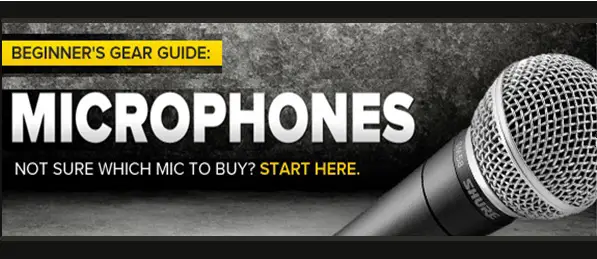
Microphone is an important equipment needed in music production for recording vocals and music instruments, and to record sound on your computer. Here we take a look at the various types of mics, various techniques used while recording, and the best options available for your studio.
Types of Microphones

- Dynamic Microphones: All purpose, versatile mic and sturdy enough to withstand rough handling. These are built to capture high sound levels from amps and from drums. If you have money to buy just one microphone. go in for a dynamic mic.
- Condenser Microphones: Another popular type which is common used for recording vocals. These are more sensitive to sound pressure and are less durable (compared to dynamic mics) because of the complicated internal mechanism. Use it for capturing better vocals
- Ribbon microphones: Long before Dynamic and Condenser mics were introduced, ribbon mics were commonly used in the radio industry. These natural-sounding microphone mics nicely captured higher notes without the harshness and sounded warm. With recent ribbon mics looking thinner and sleeker, and sturdier than their old counterparts, these are increasingly becoming popular. You may use it for live multi-instrument recording and even for home recording, if you’re looking for a more natural-sounding microphone with vintage vibe (although a bit more expensive).
Dynamic Microphones
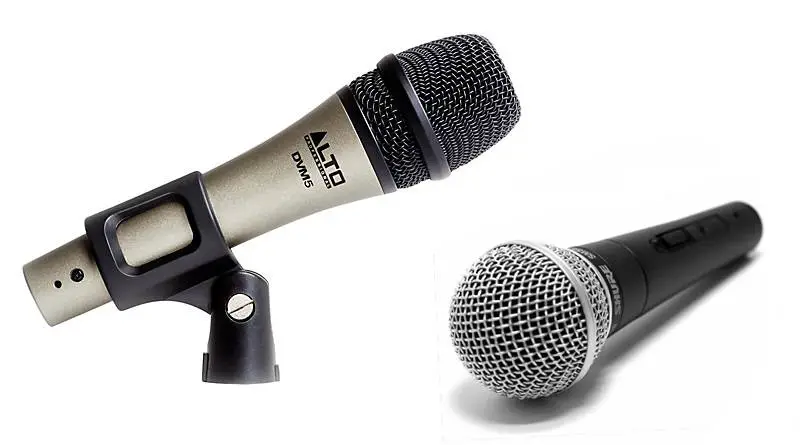
They don’t require batteries or external power. They are sturdy and more solidly built, compared to the condensers.
These are economical & no frills microphone; quite different from the Condenser mics.
This is more of a general purpose microphone and if you are just starting out and have the budget for just one mic, then it is going to be this one.
But if you want to record vocals where you want a much clearer recording, then a condenser is more suitable.
For best results, place them closer to the sound source.
They also suffer from the proximity effect, where lower bass frequencies can increase in level when the sound source gets too close to the mic.
Condenser Microphones
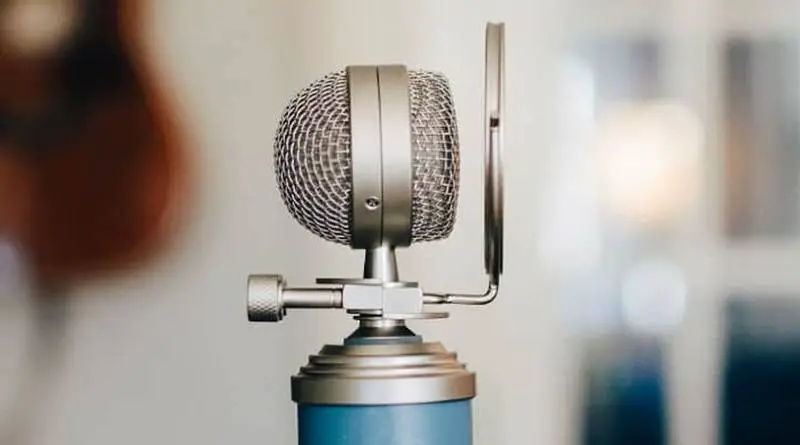
The size of the diaphragm is an important feature that you need to consider when selecting a condenser microphone.
- Large-diaphragm mics
Anybody recording his/her debut album in the studio for a major record label, is of-course going to use a large diaphragm condenser (these have a larger capsule that house a larger diaphragm).
For recording smooth vocals, these are your go-to mics, as they can add warmth to a sound.
It captures the fullness and warmth of the lower frequencies like a dynamic mic, but it still captures much of the highs like a small diaphragm condenser. Essentially, it sits somewhere in between these two!
You will still need to use a pop shield, to tone down the ‘P’ and ‘SH’ sounds.
- Small-diaphragm mics
Small diaphragm condenser microphones are typical used to record instruments that are rich in high frequency content such as acoustic piano, acoustic guitar, cymbals. These are often long and thin in shape.
Condenser microphones need Phantom power (power signal of +48 Volts) to function. Most audio-interfaces have phantom power built-in (some of these mics can also be powered using an internal battery source).
In case you are working in a setup without phantom power, you’ll need to invest in a mic preamp with phantom power capability.
Proximity Effect
As with most recording microphones, you need to be aware of the ‘proximity effect’, where the lower bass frequencies become louder as the sound source moves closer to the microphone; it can ruin your recording.
USB Microphones
USB microphones are easy to set up; just plug it in to a USB port on the computer, and you’re ready to use it.
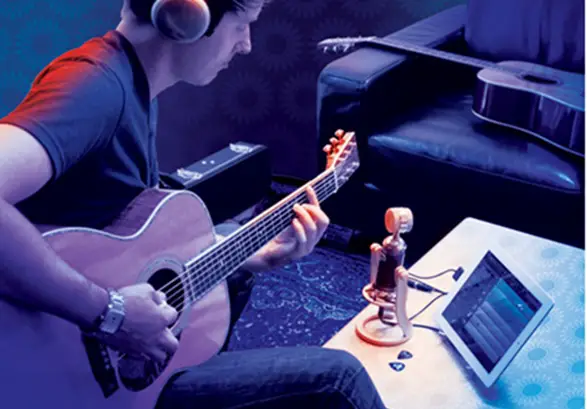
As a beginner you want something that can be plugged in quickly and get you started fast. That’s what you can do with a USB microphone. These easy-to-use mics connect directly to your Mac or PC, it doesn’t have to go via a preamp or audio interface.
Besides music producers, these are perfect for Podcasters, amateur musicians, or anyone looking to record better sound at a reasonable price, without worrying about the setup. USB microphones have only become better in recent times and can even outperform several mid-grade studio mics.
A USB microphone sends the signal either directly (via USB cable) or through an intermediary XLR cable to a small pre-amp before reaching your computer. The USB cable provides the power needed by the microphone (or the pre-amp).
XLR to USB Adapter
If you already own an XLR mic that you like, an XLR to USB interface is the simplest and most affordable way to record that microphone onto your computer. These adapters convert an XLR microphone’s analog signal to digital audio that you can record with your computer’s DAW software.
There’s a wide range of USB microphones available. For less than $100, you can pick up a USB condenser microphone that connects directly to your computer to capture crisp, accurate audio of vocals, acoustic guitar, voiceover auditions, and podcasts. You also get higher-end USB mics that are similar to the large-diaphragm condensers and have dynamics that you’d find in pro recording setups.
Microphones for Recording Vocals
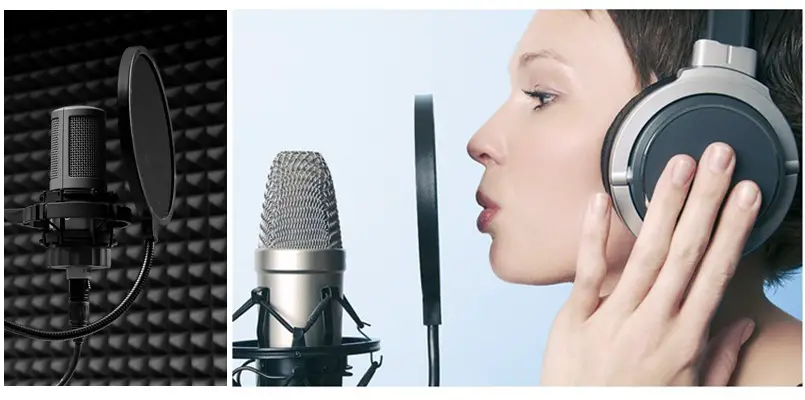
If you’re looking for a good mic for vocals, you should consider buying a condenser mic that will give the best quality recording (for vocals). However, most newbies have a limited budget and are not in a position to buy separate mics for vocal, and other instruments. In that case, you may consider buying a good dynamic microphone; these work reasonably well for all instruments as well as for vocals.
How is USB Microphone for Recording Vocals?
USB microphones are affordable, easy to use, and good enough for most novice singers. So if you have setup a basic home recording studio and are looking for a reasonable microphone to record vocals, a USB mic can be a good option.
Shure SM58
The Shure SM58 is a favorite with many musicians, artists, and speakers due to its ruggedness. It’s resistance to feedback, rugged casing, and ergonomic capsule makes it perfect for live performances as well in the studio.
It’s the hands down favorite if you’re looking for an affordable mic. You wouldn’t think that pro studios with unlimited budgets would ever use a $100 mic to record vocals. But with the Shure SM58, it happens all the time.
Audio-Technica AT2035
Audio-Technica AT2035 is an inexpensive cardioid condenser microphone (you also get a pop filter with 2 layered mesh and a 10-foot XLR Cable).
The mic has a large diaphragm for natural sound. Cardioid polar pattern prevents sounds coming from the sides and rear. Amazing starter XLR microphone for the price; use it for recording vocals or even for general use.
Rode NT1A
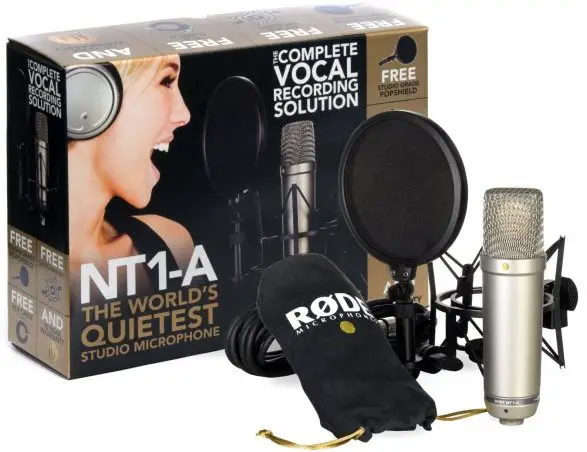 The Rode NT1A is the best mid-priced vocal mic. It’s great for recording vocals, guitars, and percussion instruments. The combination of price, sound quality, and overall reputation make this mic the obvious choice for your first vocal mic. In home studios throughout the World, there is probably none more popular.
The Rode NT1A is the best mid-priced vocal mic. It’s great for recording vocals, guitars, and percussion instruments. The combination of price, sound quality, and overall reputation make this mic the obvious choice for your first vocal mic. In home studios throughout the World, there is probably none more popular.
Recording Microphones: What to Buy?
You can always start with one good condenser mic for your studio. A condenser microphone is one that needs power, either from a battery or phantom power (most mic preamp and audio interface have it).
Many vocalists use a Shure SM58, because they are rugged, and can be used on stage, but for studio purposes, you need something that provides stunning clear vocals.
If you are going to record vocals and guitars, the popular choices is to go with condenser mic; these are more sensitive compared to the dynamic mics.
Dynamic and Ribbon mics are the other types that are also used. These have different applications, particularly if you are going to use things like Drum mic’ing.
Microphone Accessories
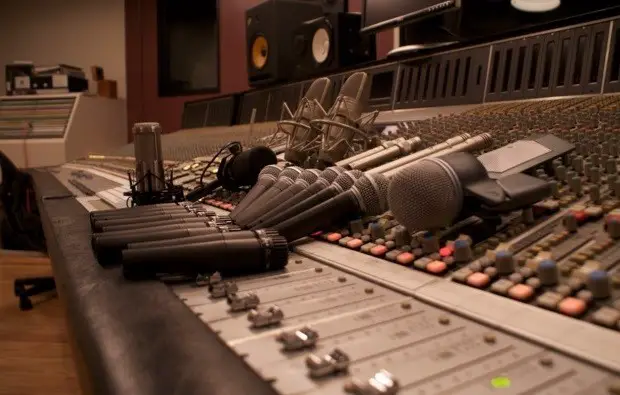
You get several useful microphone accessories such as Microphone arms, goosenecks, Microphone stands, belts and brackets, pop filters, that will help you get the most out of your recording session.
There are a few mic accessories that you will most likely need.
Mic stand: Since these are very sensitive mics you cannot hand hold them. They will transmit noise. Most of them will come with a shock mount for the same purpose – to prevent noise from filtering in to the mic.
Pop-filter for recording vocals. This prevents haziness sounds coming in through the recording, that can be quite harsh, so make sure you get yourself a nice pop-filter.
You may also need a Reflection filter. You might be living in a residential street with traffic noise or you might be in a room that is reflective and you might be getting sounds that you don’t want to hear. The best way to deal with it is to get a good Reflection filter and this is just a piece of acoustic foam that sits behind the mic and comes around it, and makes sure that the reflections are stopped from entering it.
Best Recording Microphones
Best USB Microphones
You can choose from a wide range of USB mics: budget-friendly USB microphones under $100, to USB versions used in pro studios.
USB to XLR adapter
Shure MVX2U MOTIV XLR to USB Adapter Digital Audio Interface
Blue Yeti USB (& Yeti Pro Studio) Microphone
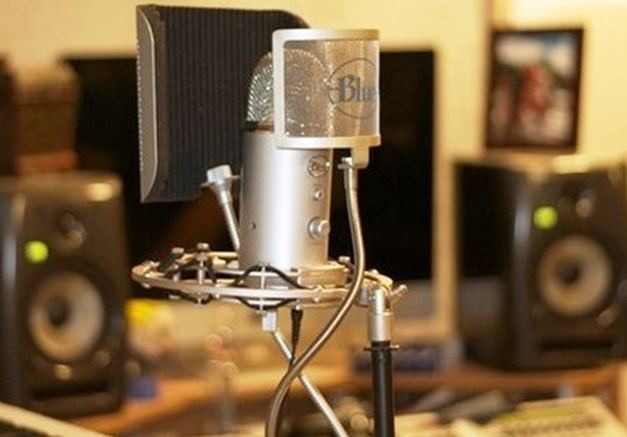 Blue Microphones Yeti is among the most popular and the best condenser microphones (with USB connectivity) that can capture pro-quality audio. The Yeti and Yeti pro studio mics are almost similar, except for a few things. Yeti Pro studio has more features (hence the Pro in the name) and features an Analog XLR output.
Blue Microphones Yeti is among the most popular and the best condenser microphones (with USB connectivity) that can capture pro-quality audio. The Yeti and Yeti pro studio mics are almost similar, except for a few things. Yeti Pro studio has more features (hence the Pro in the name) and features an Analog XLR output.
The mic has several modes for various situations.
Being a condenser microphone, you need to record in a fairly silent environment, else it will pick up ambiance noise.
It has a small footprint, which makes it suitable even for desktop use. The base of the stand has sponge on the bottom to avoid marks. The heavy metal construction and standard threaded mount (for larger stands) makes it more durable (usable for stage or studio use as well).
- Blue Yeti: Buy on Amazon | Buy on zZounds
Retro, Vintage Style USB Microphone
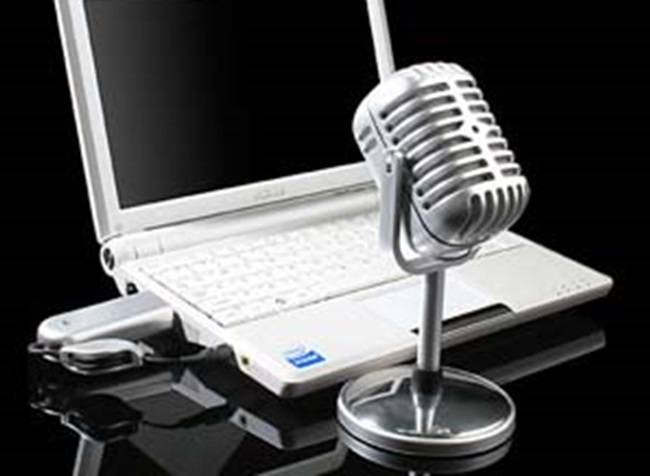 Retro, vintage-style USB microphones look like the classic microphones from the past but offer modern connectivity through USB. These can be used for various applications, including live performances, studio recordings, podcasting, streaming, and more.
Retro, vintage-style USB microphones look like the classic microphones from the past but offer modern connectivity through USB. These can be used for various applications, including live performances, studio recordings, podcasting, streaming, and more.
Best Dynamic Microphones
Audio-Technica ATR2100-USB Cardioid Dynamic USB/XLR Microphone
The Audio-Technica ATR2100-USB is great for live performance, podcasting, home studio recording, field recording, and voiceover. The XLR output connects with a conventional sound system input for use in live performance. The microphone plugs right into your computer USB port and works seamlessly with your favorite recording software. Cardioid polar pattern reduces pickup of unwanted sounds from the sides and rear. Buy on zZounds…
Shure BETA 58A Supercardioid Dynamic Microphone
The Shure BETA 58A is designed for professional sound reinforcement and project studio recording. The advanced pneumatic shock mount system of this microphone eliminates mechanical noise levels and gives crystal clear sounds. Buy on zZounds
Shure SM58-CN Cardioid Dynamic Vocal Microphone
The Shure SM58-CN Cardioid Dynamic Vocal Microphone is among the most popular mics and is usually the first choice for most vocal performers. Ruggedly built, and designed to target the main sound source while minimizing background noise, the SM58 delivers clear vocal reproduction. Buy on zZounds…
Best Condenser Microphones
Condenser Mics by Audio-Technica, Shure, & Rodes are quite popular.
Rode NT1-A Studio Vocal Condenser Microphone
The NT1-A is one of the world’s quietest microphones — ideal for vocals, voice-over, and to record acoustic instruments. Use it for recording vocals, guitar, piano and other instruments. It works well with most applications. This is a favorite with serious musicians to record killer vocals, this large-diaphragm condenser mic has super-low noise and a great frequency response.
Rode NT-USB USB Condenser Microphone
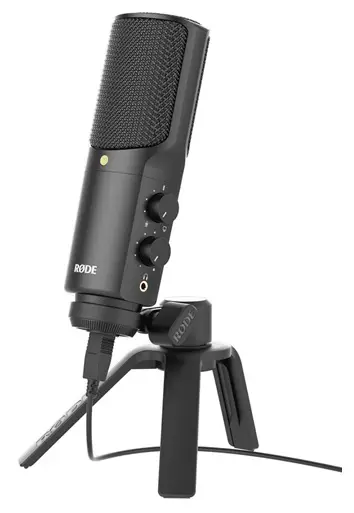 The Rode NT-USB is a versatile microphone that can be used for sound recording, podcasts, or voice-over recording. It plugs easily into a PC, Mac or iPad and you can start recording right away. It includes a stand, pop filter, and a headphone output for zero-latency monitoring. You can conveniently place it on a tripod and it has easily accessible knobs to control volume.
The Rode NT-USB is a versatile microphone that can be used for sound recording, podcasts, or voice-over recording. It plugs easily into a PC, Mac or iPad and you can start recording right away. It includes a stand, pop filter, and a headphone output for zero-latency monitoring. You can conveniently place it on a tripod and it has easily accessible knobs to control volume.
Shure Microphones
Shure’s microphones are the world standard, when it comes to recording, and includes several time-tested, road-tested, and drop-tested mics.
Shure SM58 Dynamic Handheld Vocal Microphone
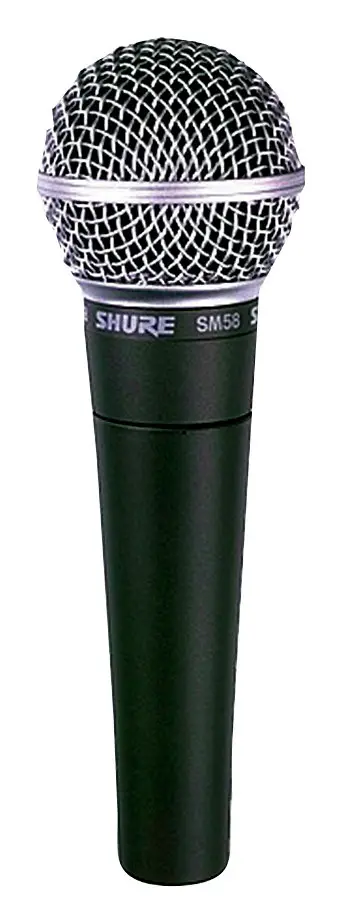 Shure SM58 Dynamic Microphone is famous for its warmth, clarity and durability, and has been a favorite for musicians worldwide for a long time now. It gives an edge to your music that separates the professionals from the hobbyists.
Shure SM58 Dynamic Microphone is famous for its warmth, clarity and durability, and has been a favorite for musicians worldwide for a long time now. It gives an edge to your music that separates the professionals from the hobbyists.
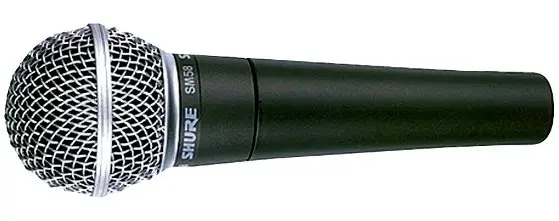
Shure MOTIV microphones
The Shure MOTIV digital microphones come with retro design.
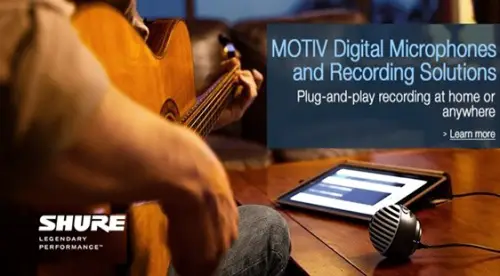
Sennheiser Microphones
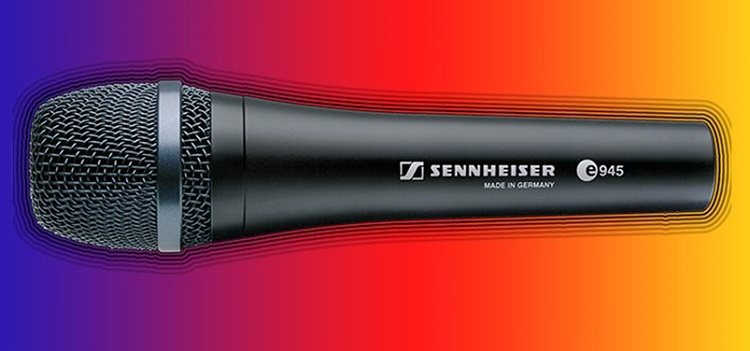
Sennheiser has a diverse lineup of mics, which provide plenty of options for accurate recording of all your acoustic instruments and vocals.
Sennheiser handheld dynamic cardioid mics are extremely popular with vocalists and stage managers. You can choose a bundle that includes a stand and cable.
The Sennheiser mic range covers a wide range of products. Some of the popular ones include:
- Sennheiser E845 and E835 vocal mics (dynamic), perfect for stage use
- Sennheiser E609 (dynamic), ideal for guitar cabs
- Sennheiser E602 for low-frequency instruments such as kick drums
Neumann Microphones
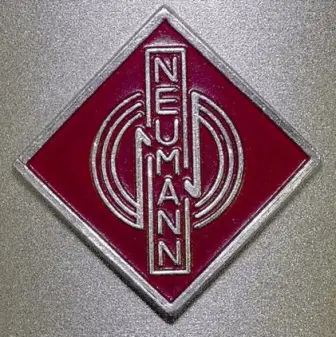 German brand Neumann is synonymous with high-end microphones and makes sound production units for radio studios, theaters and concert halls, in addition to making microphones.
German brand Neumann is synonymous with high-end microphones and makes sound production units for radio studios, theaters and concert halls, in addition to making microphones.
Neumann TLM-103 Studio Microphone
The Neumann TLM 103 Studio Microphone is basically a large-diaphragm condenser for vocals, voiceover, and just about everything else. The mic delivers detailed & clear sound at extremely low noise. Minimal self-noise and a wide dynamic range. The TLM 103 is used for pro or project studio use, for classical recordings, Foley work. Its also robust for live stage use.
Neumann TLM 107 Multi-Pattern Condenser Microphone
The Neumann TLM 107 is a 5-pattern large-diaphragm condenser that’s capable of capturing everything from vocals to drums with pure accuracy, plus an airy 8 kHz boost, especially when tracking vocals. Use it for studio, broadcasting or for demanding home recording applications.
Related:



Leave a Reply